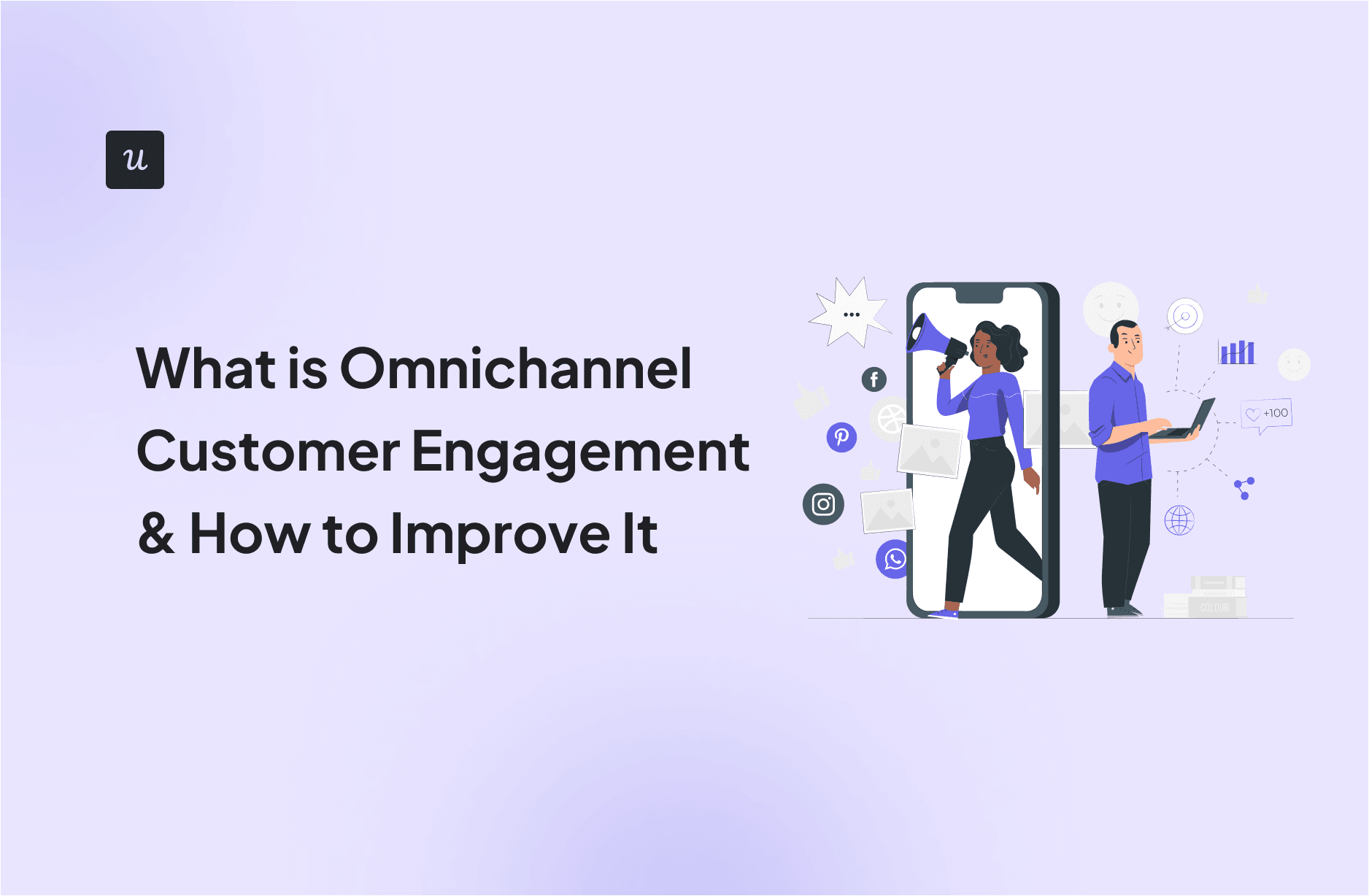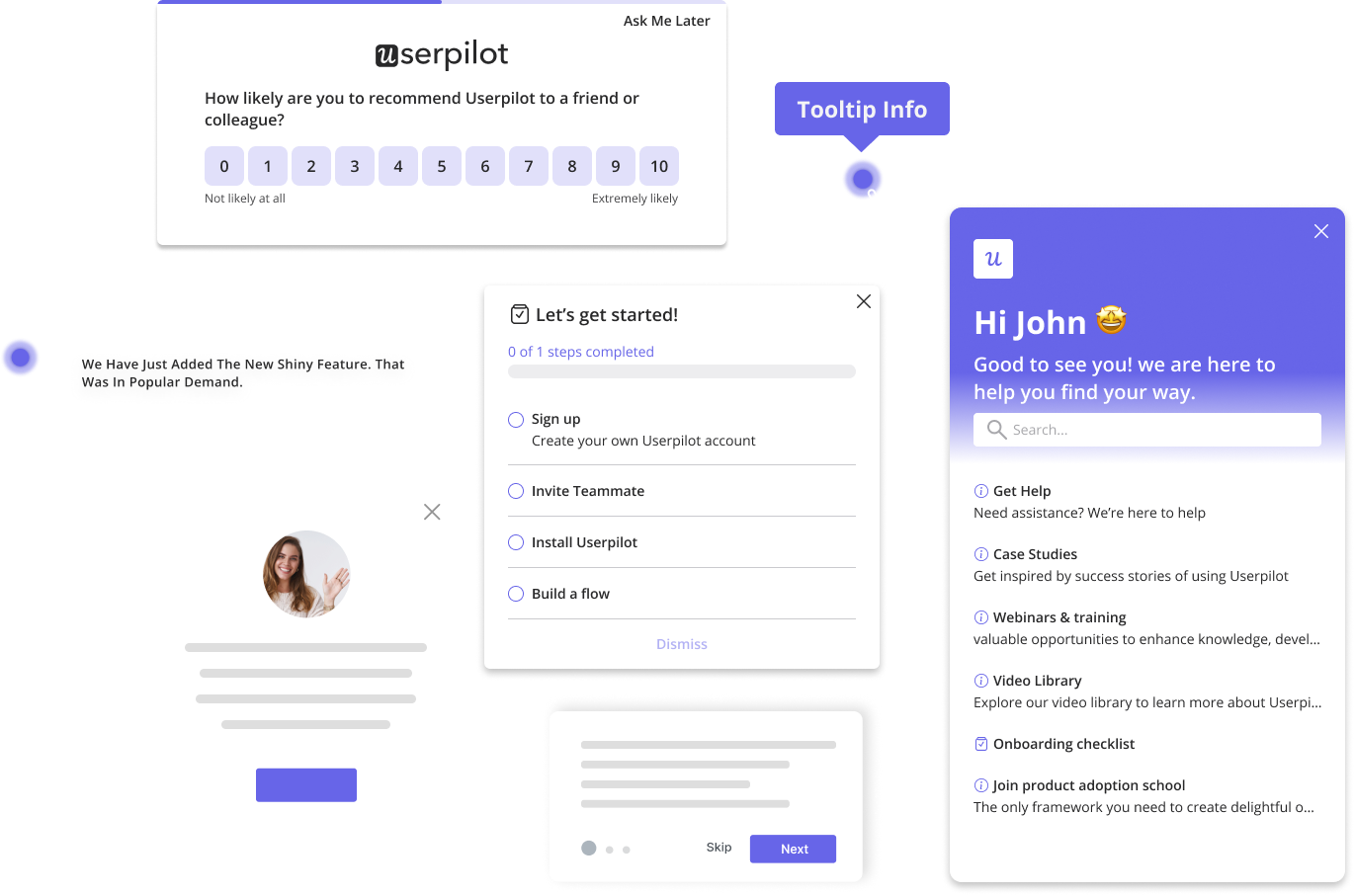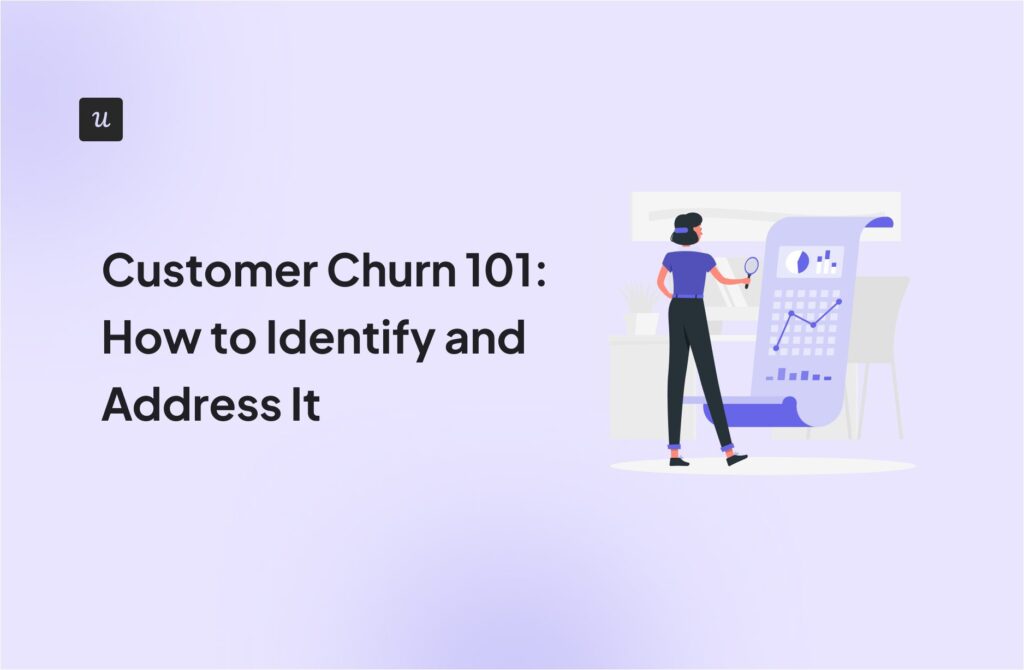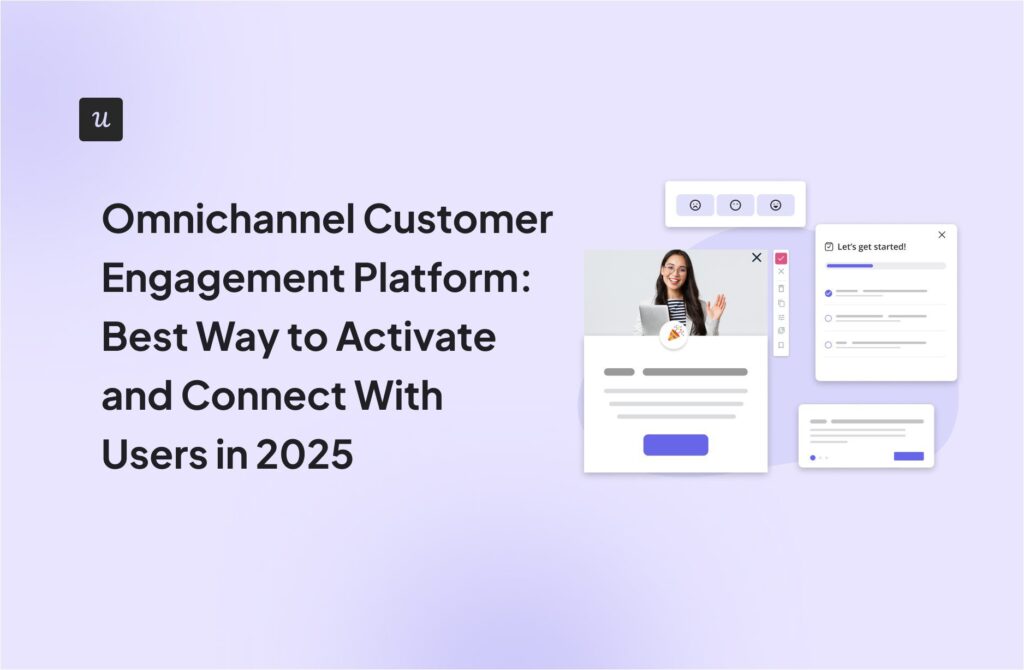
What is Omnichannel Customer Engagement & How to Improve It
I work with a lot of SaaS teams, and one question pops up constantly: how do you keep customers engaged across all the different channels they use? It’s a big deal, not just for customer success but for product management too. If your messaging and experiences feel scattered, you’ll lose trust fast.
That’s why you need to invest your time in omnichannel customer engagement. Let’s break down what it means, why it’s worth your time, and how to build a strategy that keeps customers happy and loyal, wherever they are.
Get The Insights!
The fastest way to learn about Product Growth, Management & Trends.
What is omnichannel customer engagement?
At its core, omnichannel customer engagement is about keeping everything connected. It means your customers get a seamless experience, whether they’re browsing your website, using your app, reading an email, or chatting on social media.
I like to think of it as guiding customers through their entire journey without ever making them feel like they’ve stepped into a different brand space. It’s one smooth experience for the users, no matter the channel.
Why is an omnichannel customer engagement strategy important?
I’ve seen firsthand how messy it can get when customer interactions are scattered across different channels. You end up with disconnected conversations, frustrated customers, and a team constantly scrambling to patch things together.
A strong omnichannel strategy fixes that. It pulls all your multiple touchpoints into one smooth flow, and that pays off in big ways:
- You can truly personalize the experience: By integrating data from every channel, you get valuable insights into what customers do, like, and need. That makes it easy to tailor messages and offers so they actually land, and creates a much more engaging customer experience.
- You meet (and often exceed) customer expectations: Let’s be honest, customers today expect to complete tasks or get help in just a few clicks, no matter where they start. A successful omnichannel strategy means they never feel like they’re starting over, which goes a long way towards fostering loyalty.
- You make it easy to stick around: People stay loyal to brands that let them move seamlessly between channels on their own terms. Whether it’s live chat, an email follow-up, or in-app help, that effortless feel keeps them coming back.
- You drive increased customer retention: Customers notice when you’ve put in the work to create a smooth journey. That thoughtfulness builds stronger relationships, turns them into loyal customers, and helps keep churn low.
The challenges of building an omnichannel customer engagement strategy
Even with all its clear upsides, I see a lot of SaaS teams struggle to improve their customer engagement across multiple platforms. Despite your best plans, there are a few common roadblocks that can break the flow of the customer journey and slow you down.
Unifying customer data without creating data silos
In my experience, this is usually the biggest headache. Many businesses struggle because each team (customer service, marketing, or sales) holds onto a bunch of CRM data, records, or customer insights. That means data from one team often isn’t fully accessible to the others.
These silos make data management a nightmare and kill your ability to share insights or deliver a consistent experience. And merging everything into a single system isn’t easy either. Between CRM platforms, analytics tools, and communication channels (including your call center), you’ll spend serious time and resources pulling it all together.
Facilitating effective communication
With so many ways to connect (from messaging apps to social feeds to your website), I’ve seen just how tricky it can be to keep everything aligned. If you want to stay present across multiple platforms, you’ll need careful planning and a lot of coordination.
Each channel often needs its own resources and speaks to a different audience. So when you decide to shift to a true omnichannel platform, you’ll have to invest in the right tech and make sure your team is properly trained.
And if your conversations aren’t aligned, customers will end up repeating themselves across different touchpoints with different reps. Trust me, that’s guaranteed to frustrate customers, hurt trust, and drive up customer churn.
Creating consistency across channels
Think about how customers feel: if they have a smooth, helpful interaction on your website, they’ll expect the same on your social feeds. And they’ll want that experience to line up with what happens in store, through online shopping, or even in self-service options.
The challenge is making sure everything feels connected, like it’s coming from one channel, even as you adapt to each platform’s quirks. That’s where I see teams stumble, and why customers sometimes get mixed signals that disrupt the customer journey.
How to create an effective omnichannel customer engagement strategy?
So now that we’ve covered the big wins and the usual roadblocks, let’s talk about how to actually create an omnichannel approach that works. These are the six steps I think make the biggest difference:
Identify the preferred channels your customers use
One of the biggest mistakes I see is companies trying to be everywhere at once. You don’t need to chase every channel. You just need to show up where your customers spend their time already. That’s why figuring out their preferred channels is so critical.
A great example is Cledara, a SaaS company that realized email alone just wasn’t cutting it for them. They used Userpilot to deliver in-app messages instead, and the difference was huge:
“Within a week, we were able to register several dozen companies already saying they’re interested in the new feature. With email, you’d get the same number of responses within two months.”
— Gerard Masnou, Head of Support and Operations at Cledara
That’s the power of meeting customers where they are. Once you know where your customers really hang out, you can tweak your engagement efforts and share more relevant content to match.
Map the customer journey to understand customer expectations better and optimize the experience
These days, customers jump between channels without thinking twice. They move back and forth on your website, emails, live chat, and social feeds. So if you don’t understand exactly how they’re making their way through this customer journey, it’s easy to lose them along the way.
That’s where customer journey mapping becomes important. I find that it gives teams a clear picture of what customers want, what they expect at each touchpoint, and how to put together a truly consistent experience.
Your goal is to make sure there are no awkward gaps as customers switch channels. Ask yourself:
- How well does each channel work on its own?
- How do these channels connect to guide customers forward?
- What ultimately convinces them to stick around?
- And how can you keep the customer experience smooth without disrupting it with clunky transitions?
If you get this part right, the rest of your customer engagement efforts become much more effective.
Create a marketing strategy across multiple channels
Once you know how customers progress through your pipeline, it’s time to build a plan. A solid SaaS marketing strategy should attract, nurture, and keep your leads engaged.
But not every tactic works on every channel. That’s why I always remind teams to match the message to the medium. So, for example, be more direct and actionable when guiding users in-app, but lean on emails for deeper, educational content.
And keep in mind: each channel comes with its own audience expectations.
- Long-form videos are perfect for YouTube.
- Quick hits work better on TikTok, Reels, or Shorts.
- Emails and blogs handle in-depth content, while Twitter (or X) is built for sharp, punchy takes.
- Visuals do great on Instagram and Facebook.
This kind of playbook is how you connect with customers across multiple channels without losing your on-brand message.
Ensure unified messaging and consistent customer experience across channels
Your tone might shift a bit from emails to social to in-app, but at the end of the day, it all needs to feel like one unified conversation. That’s how you build trust and keep customer loyalty strong.
I see too many teams treat each channel like its own island. Instead, go for consistent messaging that feels like it’s coming from the same voice, even if you’re not repeating the exact words. A strong omnichannel customer experience strategy connects your support teams, marketing, and product teams around a single, unified voice.
One of the best ways to do this is by delivering a personalized experience across channels. For example, your email campaigns shouldn’t live in a vacuum. They should reflect each customer’s in-app behavior and tie back to the overall customer experience you’re creating.
Invest in your marketing team (and the right tools)
From what I’ve seen, you can’t build a strong omnichannel engagement strategy without two things: the right people and the right marketing tools.
A lot of tools look good on paper. But you want a stack that helps your team integrate, collect, and analyze data from all your customer interactions (purchases, product use, feedback) in one place. You could even layer in artificial intelligence to spot patterns you might miss.
At Userpilot, we’ve built features that help teams capture and analyze deep insights. It then lets you use them to build personalized, contextual experiences across web, mobile, and email. Exactly what you need to empower customers and keep the experience truly personal.

But of course, the best tools won’t get you far without the right marketing team structure. And SaaS companies in particular need to invest in digital marketing and retention strategies that help boost satisfaction and keep churn low.
Use an omnichannel customer engagement platform
If there’s one tool that truly holds everything together, it’s an omnichannel customer engagement platform. It bridges the gap between your customers and your customer service representatives, and honestly, I think it’s the backbone of most successful teams.
With the right platform, you can easily collect and store data from every touchpoint, turn it into meaningful customer insights, and apply those to each unique customer journey. It’s also great for continuous improvement, so you’re always refining how you engage and support customers.
Let’s get specific, though. How exactly do you make this happen? Here’s how:
How a customer engagement platform can help you create a seamless experience
I’ve worked with enough teams to know that pulling off a truly seamless customer experience is tough without the right platform. Here’s how Userpilot makes it easier:
Trigger email campaigns based on real-time customer behavior
One of my favorite things about Userpilot is that you no longer need to rely on complex integrations or third-party systems to send emails. It’s all built right in.
Now, you can set up email campaigns directly inside Userpilot, so that they’re triggered by real-time customer behavior. Whether it’s a user completing a key feature, dropping off at a certain step, or sending in customer queries, you can reach out instantly with the right message.
It’s a simple way to deliver more proactive service, keep customers engaged, and boost overall customer satisfaction, without any extra tools or delays.
Something that teams tell me they love about Userpilot is how smoothly it handles collecting data. You can set just about any interaction as a trigger, whether it’s with a flow, checklist, NPS survey, form, or even a simple button click.
From there, you can send this customer data wherever it needs to go, for the other tools in your stack. It’s simple and gives you great data insights, tightens up your omnichannel engagement, and makes sure nothing gets lost between platforms.
Use HubSpot data to set in-app experiences
If you’re already using HubSpot, you’ll like how seamlessly it works with Userpilot.
You can pull in HubSpot data (from purchase history to engagement patterns) and build custom segments based on what users do inside your product. That means instead of just guessing at customer needs, you’re building in-app experiences around real user behavior.
It also means you can easily set up contextual Hubspot email campaigns that tie directly to a user’s in-app actions, and make your outreach far more relevant across the entire customer journey.

Collect customer data to build user segments and provide personalized experiences
Welcome surveys in Userpilot are a simple but powerful way to gather customer feedback right from the start. They help you figure out who your new users are, what brought them to your product, and what they’re hoping to solve.
This also helps you shape a clear user persona right from the start. With that insight, you can segment users effectively and deliver a personalized customer experience that feels spot-on from day one.

Welcome surveys can also give you a ton of valuable information for engaging with customers on different channels.
Use in-app surveys to learn what customers expect from your brand and optimize your omnichannel strategy accordingly
You’re not just limited to welcome surveys with Userpilot. The platform gives you a full library of in-app survey templates (from product research to customer satisfaction), so it’s easy to collect the customer feedback that matters most.

You can pick a ready-made survey or build one from scratch, then trigger it at any customer touchpoint. That way, you get to see how different segments react to new features or updates, and to learn what they like, dislike, or expect next.
Here’s what a user had to say about using Userpilot for this:

Insights like these help you fine-tune your product and create a more personalized customer experience across channels. They also keep your customer communication sharp, so you’re always in sync with what customers want.
Improve your omnichannel customer engagement strategy with Userpilot!
If you want to keep customers engaged (and coming back), a strong omnichannel customer engagement strategy is how you build customer loyalty that sticks.
And even though I might be biased, Userpilot is the tool for it. It helps you pull in real data, personalize experiences across every channel, and stay in sync with what your customers need. Want to see it in action? Book a Userpilot demo and we’ll walk you through it.








